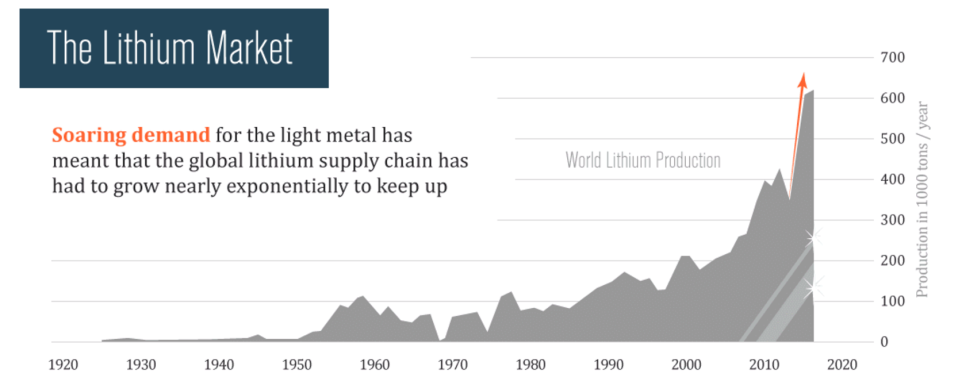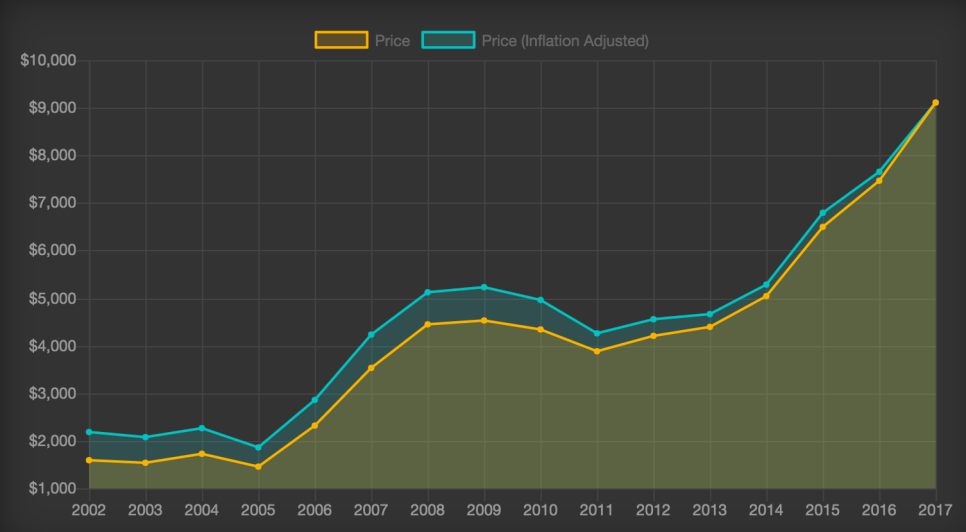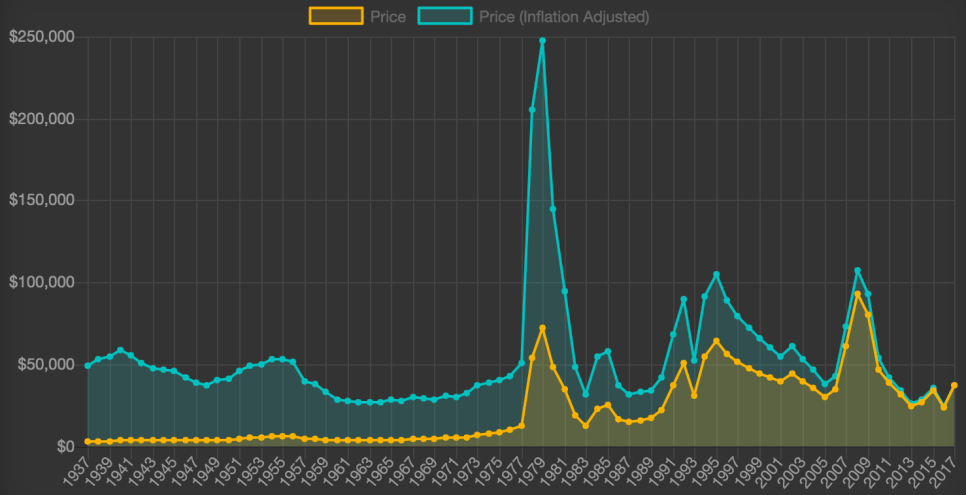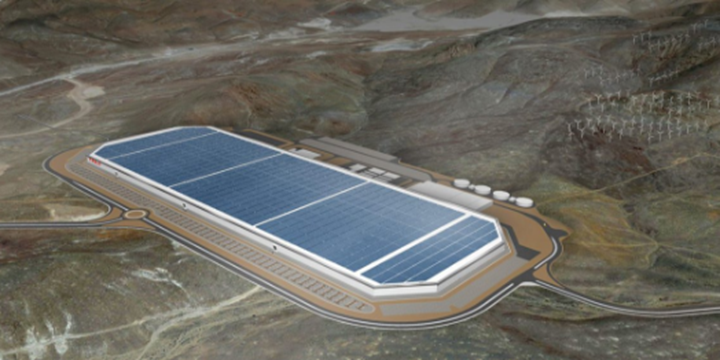With the recent emergence and popularity of Tesla (NASDAQ:$TSLA), many of us believe that the automobile industry is moving away from vehicles powered by fossil fuels towards electric vehicles. Just as it is important to transfer any asset environmentally as this shift occurs, financial assets must make the move as well. As investors divest from fossil fuels, questions arose regarding where the money should be reinvested to and what the new petrol could be. For many, the answer to these questions is the minerals that are used to make rechargeable batteries — Tesla’s Gigafactory 1 alone is expected to double its battery production over the next year.
However, there are many ways to make different batteries, and it is quite unlikely that a single battery chemistry will be exceptionally better than the rest. So, even though electric vehicles is rising in production, it is likely that different manufacturers will use different battery chemistries, which uses different kinds of minerals.
But like all things, there are some minerals that are more widely used than others, such as lithium, cobalt, nickel, graphite, and manganese. If you are interested in getting divesting from fossil fuels and looking into investing in cleaner energy, below are some companies that are developing new mining projects for the more popular minerals used in rechargeable batteries; thus potentially benefiting from the rising demand of electric vehicles.
Lithium
This is a pretty obvious investment as the material is in the name — lithium-ion batteries. However, investments in lithium won’t yield high returns as there is quite a large number of untapped resources. It can still make a rather interesting investment nonetheless, as new mines will have to operate in order to meet the rapidly growing demand.

The majority of lithium in the world comes from brine deposits located in Chile, Argentina, and China. If you are interested in investing in lithium, take note of these companies — as they control a large part of the production of lithium in these areas: Albemarle (NYSE:$ALB), FMC (NYSE:$FMC), and Chile’s Sociedad Quimica y Minera de Chile (NYSE:$SQM). With the rising price of lithium, these companies are no doubt enjoying the benefits.
While production and demand for lithium have been slowly rising, it has reached a new high recently with the mass-marketing of electric vehicles such as the Tesla Model 3. As such, Tesla Gigafactory 1 will need to obtain a large amount of lithium, especially with its goal to produce enough batteries for at least 500,000 cars in the company year. Batteries for 500,000 cars means that Tesla would need about 30,000 tonnes of lithium in 2018 alone. By the time the automobile company go into full production in 2020, 30,000 tonnes could triple to 90,000 tonnes.
With an almost exponential growth in demand, thanks to projects such as Tesla’s, opportunities to redefine lithium’s logistic pipeline grows as other companies begin to look for new deposits and launch new mining projects.

Just recently, Tesla said it will be working with major mining companies as well as promising junior companies in order to ensure its future supply of lithium. Tesla assured investors that lithium supply is already secured for 2017, however the more realistic amount of lithium needed is the 2018 supply.
Considering that there are some great lithium deposits only hours away from the Tesla Gigafactory, there are opportunities to cut logistics costs. Tesla has already signed a conditional supply agreement with Pure Energy Minerals (TSX.V:$PE.V), a mining company with claims on 9,500 acres of lithium brine in Clayton Valley, a four-hour drive from the Tesla Gigafactory.
Other junior mining companies such as Lithium Americas (TXS:$LAC.TO) show promise for investors as the company has claims of some lithium deposits in the areas surrounding the Gigafactory. Lithium Americas also own the 3rd largest lithium brine reserve in the world, located in Argentina at the Cauchari-Olaroz lithium brine deposit.
Another startup company to keep an eye out for is LiCO Energy Metals (TSX-V:$LiC), who also own large amounts of lithium claims in Nevada. Not only that, they also have claims on lithium deposits in Chile.
Both companies’ lithium mining projects are mostly still in early development, however infrastructure is now beginning to be put in place to prep for the start of production as financing is being secured and met.
Cobalt
This metal is used in the cathode of in some of the most popular battery cell chemistries — NCA, LiCo, and NMC. Cobalt helps with the stability and increases capacity of these batteries. As such, it is a pretty key component to making the rechargeable batteries that is now so high in demand.
Compared to lithium, a lot more investors are scrambling to invest in cobalt. This is because the supply for cobalt is much more limited than that of lithium. Before electric vehicle’s rise in popularity and cobalt became a key component in lithium-ion batteries, cobalt was a market that was oversupplied. Now, lithium-ion batteries accounts for 40% of cobalt demand and the growing demand is expected to cause a deficit in the cobalt supply. The rise in demand and low supply has caused the price of cobalt to double over the past year.

Tesla CTO JB Straubel states that he was more concerned about the supply chain for cobalt rather than lithium because of cobalt is more rare. In addition to an unsteady supply chain, cobalt is produced as a by-product from the mining of nickel and copper, thus there are very few companies that only produces cobalt.
Tesla did not disclose how much cobalt is used in its batteries, however estimates have suggested that an average Tesla vehicle need about 20 kg of cobalt while a Tesla Powerwall would need about 7 kg of cobalt.
However, those who are interested in investing in cobalt should have a thorough understanding of where the cobalt is coming from. This is because the majority of the world’s cobalt is produced in the Democratic Republic of Congo (DRC), one of the poorest and politically unstable countries in the world. The cobalt industry in the DRC have been plagued by claims of child labor as well as unsafe working conditions. As such, the probability that a geographical shift should occur due to rising demand and a search for a more steady, stable supply chain is pretty great. From the demand that the Tesla Gigafactory is creating, it is likely that the shift of cobalt production will be in North America.
Besides the DRC, Canada is looking pretty promising for those who wish to invest in cobalt. LiCo Energy Metals, a junior mining company that was previously mentioned, owns a cobalt project in Canada located in the district of Temiskaming in Ontario, Canada. LiCo Energy Metals is looking to be rather optimistic investment in the long run as it has both lithium and cobalt projects that are in early stages of development.
While there are currently no active mines in the US that are producing cobalt, there are a few in development as demand for the metal grows. eCobalt (TSX:$ECS.TO) has a project called Idaho Cobalt Project (ICP) that is looking pretty promising when it comes to cobalt investing. However, the project is not particularly large — under its current structure, an estimated 1,500 tonnes of high purity cobalt sulfate is to be produced annually. The mine life is projected to be 12.5 years. Nevertheless, financing has largely been secured, and a new feasibility study could help with increase in production.
Other good companies to consider as a way to invest in cobalt are Cruz Capital Corp (TSX:$CUZ.V) and CobalTech (TSX:$CSK.V).
Cruz Capital Corp has around 6 projects in early development in North America, along with hundreds of potentially successful claims in Ontario, British Columbia, and Idaho. Most of these claims still need feasibility studies as well as funds; however, with the rapidly increasing price of cobalt and high demand, there is a great possibility that many of them will attract financing and be profitable.
CobalTech is another junior mining company that is showing great promise for potential investors wanting to invest in cobalt. The company has been claiming mines that had been producing cobalt before the price collapse, and have plans to restart the mines due to recent demand and rising cobalt prices. The company also hopes to manage the entire process of cobalt production, not just mining.
Besides traditional efforts to find new deposits as a way to mine cobalt, some companies have looked to recycling as a way of acquiring cobalt. Batteries degrade over time, and while most of the batteries used in electric vehicles are meant to last for a long time, they will still eventually need to be recycled.
For those looking for long-term cobalt investing, consider companies that are beginning to develop ways to recycle batteries as a way to obtain cobalt.
Such a company is American Manganese (TSX:$AMY), who is already developing processes that recycle still-usable metals inside already-depleted batteries. The company originally developed the process to produce high-quality manganese at its Artillery Peak manganese mining project in Arizona and is now working to adapt the technologies to cobalt and manganese battery recycling.
In addition to the research in battery recycling, the company also have a traditional gold/high-grade cobalt mining project located in British Columbia, in Canada. Earlier this year, the company teased that they have been approached by interested companies for a possibility of a joint-venture in regards to the project.
Summary
While other minerals are very likely to benefit from the rising demand for lithium-ion batteries — such as nickel and graphite — lithium and cobalt are more critical when it comes to short-term demands. Thus, many investors are looking to invest in these metals.
Featured Image: twitter










